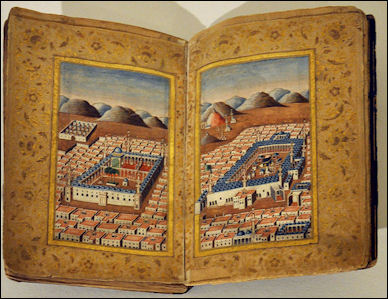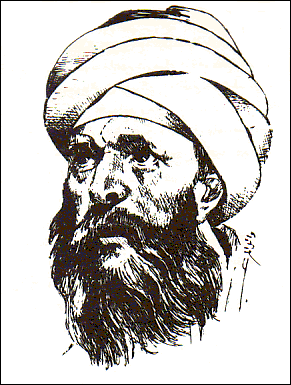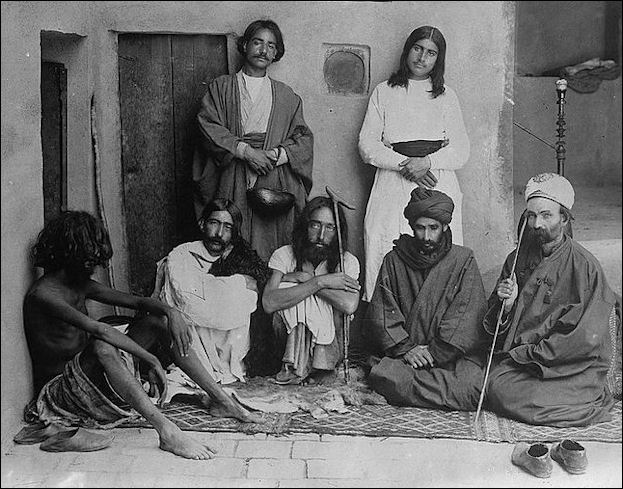Home | Category: Muslim Groups / Sufis
EARLY HISTORY OF SUFISM

Sufi mystics and attendants
Sufism, or Tasawwuf as it is known in the Muslim world, is a mystical form of Sunni Islam whose members pursue a spiritual experience using bodily discipline and mystical intuition. It also incorporates ecstatic experiences and the veneration of Muslims "pirs,"or saints.
Sufism emerged during Islam's early years, when Islam was expanding into places like India, where mysticism was very much alive. Early Sufis believed that Islam placed too much emphasis on worldly concerns, rituals, and legalities. They wanted a form of religion that led to inner ecstasy [Source: Encyclopedia.com].
From the earliest days of Islam, some Muslims have been attracted to mystical interpretations of their religion. The term Sufi derives from the Arabic suf , which means wool. Early Muslims used the term Sufi to refer to fellow believers who wore simple woolen garments to demonstrate their rejection of materialism and worldly temptations and their devotion to a life of asceticism and prayer. Eventually, some Sufis who had acquired reputations for their learning and piety attracted disciples who aspired to learn from and emulate these Sufi masters. Initially, Sufi followers were like students whose bonds to a Sufi teacher were based on personal loyalty. Since the twelfth century, however, most Sufis have organized themselves into orders or brotherhoods that follow the teachings of a particular Sufi master. [Source: Library of Congress, January 1995 *]
According to the BBC: “Several origins of the word 'sufi' have been suggested. It may derive from the word for 'wool' and the woollen garments worn by early Sufis. It may also have connections with the word for 'purity' and another suggestion is that it has links with the Greek 'sophia' or wisdom. However throughout history a Sufi was most often understood to be a person of religious learning who aspires to be close to Allah. They understand their purpose in life from the verse of the Qur'an; “I created the Jinns and humankind only that they may worship me.” —Quran 51:56 [Source: BBC, September 8, 2009 |::|]
Sufism was founded by Islamic purists who were disgusted with the materialism of Islam's leaders and wanted to have personal experience with and direct contact with God under the guidance of teachers or masters. Sufis have traditionally practiced their esoteric beliefs in private and that way avoided the problems that Christians branded as heretics had. There was also the understanding that Sufi experiences were so personal and unfathomable that no one would understand them even if an effort was made to explain them.
Websites on Sufis Divisions in Islam archive.org ; Sufism in the Oxford Encyclopedia of the Islamic World williamcchittick.com ; Sufism, Sufis, and Sufi Orders – Sufism's Many Paths islam.uga.edu/Sufism ; The Threshold Society sufism.org ; Mysticism in Arabic and Islamic Philosophy, Stanford Encyclopedia of Philosophy plato.stanford.edu ; Risala Roohi Sharif, translations (English and Urdu) of "The Book of Soul", by Hazrat Sultan Bahu, a 17th century Sufi risala-roohi.tripod.com ;Sufism - an Inquiry sufismjournal.org
RECOMMENDED BOOKS:
“Essential Sufism” by James Fadiman, Huston Smith, et al. Amazon.com ;
“The Garden of Truth: The Vision and Promise of Sufism, Islam's Mystical Tradition” by Seyyed Hossein Nasr Amazon.com ;
“Living Presence (Revised): The Sufi Path to Mindfulness and the Essential Self”
by Kabir Edmund Helminski, Iman Amazon.com ;
“The Principles of Sufism” by ʿAʾishah al-Bauniyyah Amazon.com ;
“Women of Sufism: A Hidden Treasure” by Camille Adams Helminski Amazon.com ;
“Al-Ghazali's Path to Sufism: His Deliverance from Error” by Abu Hamid Muhammad al-Ghazali (Author) Amazon.com ;
“Hidden Caliphate: Sufi Saints beyond the Oxus and Indus” by Waleed Ziad Amazon.com ;
“Winds of Grace: Poetry, Stories and Teachings of Sufi Mystics and Saints”
by Vraje Abramian Amazon.com ;
“The Mysticism of Sound and Music: The Sufi Teaching of Hazrat Inayat Khan Amazon.com ;
“Sufi Music of India and Pakistan: Sound, Context, and Meaning” by Regula Burckhardt Qureshi Amazon.com
Origins of Sufism
Sufism has its roots in the 8th century, when Christian asceticism was nearing its peak and Muslims who resented the materialism of the ruling Muslim elite were attempting to get at the essence of Islam through living simply like Christian monks, even though Islam has traditionally frowned upon monasticism, and having a direct relationship with God. One of their goals was to try to duplicate the conditions in which Muhammad received his revelations. Although Sufism was clearly influenced by acetic Christianity, Gnosticism, Hermitic traditions and even Buddhism it seems to be an outgrowth of acetic Islam that seems to have been motivated by fear of God, search for oneness with god and an exploration of perceived mystical notions found within the Qur’an and within Islam. As Sufism developed it was also influenced by the traditional animistic beliefs of Turks and Berbers, and Zoroastrianism of Persians and other local beliefs and superstitions.
According to the “New Catholic Encyclopedia”: Questions concerning the origins of Sufism remain extremely difficult to solve, and there are still some matters on which scholarly opinion has differed with unusual sharpness. Louis Massignon sought to prove that the origins of Sufism lie wholly within the Islamic tradition of the Qur’an and the sunnah, despite the surface facts that the Qur’an says little that could be interpreted as a justification for the ascetic life as lived and loved by the Sufis and that the hadith literature contains a number of explicit injunctions against it, for example: "There is to be no monasticism in Islam." [Source: J. Kritzeck, C. Wilde, “New Catholic Encyclopedia”, 1990, Encyclopedia.com]

Ghazali poetry Other scholars have adduced origins in the remnants of Christian asceticism within Islam after its conquests, in Zoroastrianism, and even in direct and indirect Hindu and Buddhist influences, although these scholars have fallen to quarreling among themselves. In any case, it cannot be denied that from the 8th century onward there was an increasingly influential movement, to be classified in the realm of popular religion, which produced more and more individuals willing to retire from the world in order to pursue an ascetic and contemplative life. That they may have done so partly in response to social and political instabilities and current theological controversies pales before the simple fact that they did so and, in doing so, greatly affected the course of Islamic intellectual history.
The convention of periodizing the history of Sufism is largely the result of Sufi hagiography itself. Certainly there were early Muslim ascetics, many of them with Shi’ite leanings, who eventually grouped themselves together, were nourished by an esoteric reading of the Qur’an and later by the writings of such mystics as al-Raba’ah and al- allaj, and who, increasingly as the decades wore on, sought a communal life based on common conviction and intention.
Drunken Sufis and Poets
Sufism relies on mystical knowledge held by a small, initiated circle of people. In the old days and still today, Sufis could often be recognized by their long robes and the turbans they wore around their heads.
Ever since Sufism became a popular movement, pious men of outstanding personality reputed to have gifts of miraculous powers have found disciples (murids) flocking to them. The disciple can be a kind of lay associate earning his living in secular occupations, consulting the pir or murshid at times, participating in religious ceremonies, and making contributions to the support of the murshid. In addition, he may be initiated into a brotherhood that pledges its devotion to the murshid, lives in close association with him, and engages in pious exercises intended to bring about mystical enlightenment. [Source: Library of Congress]
In the 9th century mystics, who fasted and used rhythmic breathing to send themselves into ecstatic states, became known as the “drunken Sufis.” Some of them claimed to have been wooed Allah like lover. Other said they achieved a perfect state of Islam by totally denying themselves. A few were executed for blasphemy. The “sober Sufis” who arrived in the scene a short time later, offered that mature Sufis returned to the world from the transcendence and lived like good Muslims in a humble sense.
Influence of Al-Ghazali on Sufism and Islam in General
The great Persian scholar al-Ghazali (1058-1111) was the great poet and articulator of Sufism. He also helped reconcile many esoteric Sufi beliefs with mainstream Islam and helped defend orthodox Islam from attacks by Greek-influenced philosophers. He believed that Sufi mysticism offered unique opportunities to discover the true knowledge of God but emphasized that some instruction was necessary to properly guide the the seeker. Sufis have mostly been a fringe movement. They took up the call to defend Muslim sites from the Crusaders. The sect then became organized around brotherhoods and holy places, often the tombs of the brotherhood founders. There was a secretive, spy-like quality to some of the brotherhoods.
According to the “New Catholic Encyclopedia”: From the ranks of the early Sufis came popular preachers and original thinkers who firmly founded Sufism and so disturbed the orthodox legal-theological institution of Islam that they were regarded not only as disruptive, but as bad Muslims. Into this situation was born Abu- amid al-Ghazali.. Influenced by Sufism in his youth, he nevertheless turned to the traditional sciences and to philosophy in his education and brilliant academic career. This prize student of al-Juwayni soon became a leading professor in Baghdad. As suddenly as he turned against philosophy because of the works of Avicenna, which he refuted in a book entitled The Incoherence of Philosophy, he turned against the whole orthodox system and toward Sufism. He resigned his professorship at Baghdad and began a radical reconsideration of Islam that resulted in the nearest thing to a reformation that Islam has ever experienced. [Source: J. Kritzeck, C. Wilde, “New Catholic Encyclopedia”, 1990, Encyclopedia.com]

Imam Ghazali By combining and indeed harmonizing the Islam of the Qur’an, the theologians, the legists, and the Sufis against the philosophers, he created, in his greatest work, The Revivification of Religious Sciences, a sensitive, well-structured, and comprehensive summa of Islamic religious thought. His achievements, like al-Ash‘ari's, became an integral part of Islamic orthodoxy and transformed it by opening an entire new universe of thought. Through al-Ghazali's reforming efforts kalam gained a new vision and Sufism a new respectability. For many centuries philosophical, theological, and mystical writings in Islam bore the stamp of al-Ghazali's thought.
The directions and extent of the development of that thought cannot be said to have fulfilled the plan or spirit of al-Ghazali himself. The marriage of Sufism with kalam was intellectual rather than practical. In practice the two went their separate ways. Philosophy, as has been noted above, had always gone its separate way. As a result, there was never again to be such a unified system of Islam as al-Ghazali's, though each of the areas of thought mentioned deepened as a consequence of his system. Sufism, in particular, enjoyed an immense popularity during the succeeding centuries. As its theory continued to develop, however, a multiplicity of religious folk practices and heterodox notions were kneaded into it. The speculative aspects of later Sufism were combined in a new eclectic system by ibn ‘arabI of Murcia (d. Damascus, 1240), who turned the movement in a more pantheistic direction and toward closer circles of initiates. The loose mosque communities of early Sufism gave way to larger confraternities and finally to religious orders. Elements of the monastic, the eremetical, and the mendicant states were combined in various proportions in these orders. Normally, however, a postulant came to a monastery, became a novice, led a communal life under the direction of a shaykh or pir, whose position was either elective or hereditary. Later he might go out preaching or on to another community, but the characteristic ritual of dhikr and his manner of life readily identified him as a Sufi.
See Separate Article: AL-GHAZALI (1058-1111): CONFESSIONS, SUFISM AND SUNNI ISLAM africame.factsanddetails.com
Later History of Sufism
Sufis gained strength when wealthy individuals became fascinate by the movements and used their money to found Sufi madrassahs and other institutions. Some were quite large and housed a large number of followers.
In India, Central Asia and other parts of the Muslim world, Sufis served as missionaries and were key to the spread of Islam. They often were able to win converts who were attracted by their claims as miracle workers and their message of love while playing down Islam’s rigid beliefs and rules. In some places cell-like Sufi groups infiltrated craft and trade organizations in the cities.
Arthur Goldschmidt, Jr. Wrote in “A Concise History of the Middle East”:“There was always an element of Sufism in Islam, but it emerged as a distinct movement during the second century after the hijrah. At first it was a movement of ascetics, people who sought spiritual exaltation by denying themselves the comforts of the flesh. Their driving force was a strong fear of God, but this evolved toward a belief in the love of God. Sufism could cut through the intellectualism of theology and soften the rigid legalism of "straight" Sunni (or Shi'i) Islam. It was not — s some modern writers suppose — a negation of the Shari'ah itself. Sufism also permitted Islam to bring in some of the traditional practices of converts from other religions without damaging its own essential doctrines. This facilitated its spread to central Asia, Anatolia, southeastern Europe, India, Indonesia, and Black Africa.
Sufi Sects
Sufism has never been unified. Different sects arise over different methods used to reach various goals. These included poetry, music, dance, meditation, chanting and trances. Over times different schools, brotherhoods and order developed. Turkey is home to 11 major Sufi orders and some 400 sub-orders.
The main Sufi schools, which date back to the 12th century, are: 1) the Qadiriyya school (named after And- al-Qadiriyya, al-Gilan I of Baghdad, died 1166), which is well represented in the Middle East. Africa and the Caucasus; 2) the Melvini school (named after Jalal al-Din al-Rumi) found mostly in Turkey; and 3) the Chishtiyaya ( from Mu’in al-Din Chishti of Sistan, died in 1236), based in Pakistan, India and Southeast Asia There were numerous sub orders and small orders.

Persian Dervishes
Sufi sects are often clandestine, decentralized. Some are fanatical. Some are ascetic. Many are involved with helping their communities, assisting the poor and educating the young. In the old days some were affiliated with craft guilds. Many Sufi sects do not allow women to join.
The Naqshbandi (named of Baha al-Din Naqshbandi, died 1389) sect is one of the biggest sects today. It has followers all over the Muslim world today. Naqshbandi sect members perform “zikr” in which they recite the names of God and sacred verses while doing breathing exercises in special postures and focusing their attention on particular parts of their body. The sect endured in Central Asia, through the Soviet era and reportedly was never penetrated by the KGB.
The Qadiri, Naqshbandi, and Chishti orders were among the most widespread Sufi orders in Bangladesh in the late 1980s. The beliefs and practices of the first two are quite close to those of orthodox Islam; the third, founded in Ajmer, India, is peculiar to the subcontinent and has a number of unorthodox practices, such as the use of music in its liturgy. Its ranks have included many musicians and poets. [Source: Library of Congress]
Sufism in South Asia
In South Asia the term pir is more commonly used and combines the meanings of teacher and saint. In Islam there has been a perennial tension between the ulama — Muslim scholars — and the Sufis; each group advocates its method as the preferred path to salvation. There also have been periodic efforts to reconcile the two approaches. Throughout the centuries many gifted scholars and numerous poets have been inspired by Sufi ideas even though they were not actually adherents. [Source: James Heitzman and Robert Worden, Library of Congress, 1989 *]
According to the “Worldmark Encyclopedia of Religious Practices”: “In the Bengal region Islam was spread by Sufis (Muslim mystics) and itinerant holy men and not by the patronage of Muslim rulers. As elsewhere in the Muslim world, Sufis were interested in Islamic philosophy and values. Evidence of their great impact on the culture of Bengal can be found in the preserved literature of the Sufis, the shrines (mazars) dedicated to the Sufi saints, and the continued appeal of Sufism in Bangladesh. None of the many Muslim rulers of Bengal were interested in converting the indigenous people to Islam. In fact, they were tolerant of the diverse religious practices of people in their territory, often patronizing the arts and literature of the various communities. [Source: “Worldmark Encyclopedia of Religious Practices”, Thomson Gale, 2006]
Sufi masters were the single most important factor in South Asian conversions to Islam, particularly in what is now Bangladesh. Most Bangladeshi Muslims are influenced to some degree by Sufism, although this influence often involves only occasional consultation or celebration rather than formal affiliation. Both fakirs and pirs are familiar figures on the village scene, and in some areas the shrines of saints almost outnumber the mosques. In some regions the terms fakir and pir are used interchangeably, but in general the former connotes an itinerant holy man and the latter an established murshid, a holy man who has achieved a higher spiritual level than a fakir and who has a larger following.*
Image Sources: Wikimedia Commons
Text Sources: Internet Islamic History Sourcebook: sourcebooks.fordham.edu ; Arab News, Jeddah; “Islam, a Short History” by Karen Armstrong; “A History of the Arab Peoples” by Albert Hourani (Faber and Faber, 1991); “World Religions” edited by Geoffrey Parrinder (Facts on File Publications, New York); “Encyclopedia of the World’s Religions” edited by R.C. Zaehner (Barnes & Noble Books, 1959); Metropolitan Museum of Art, Encyclopedia.com, National Geographic, BBC, New York Times, Washington Post, Los Angeles Times, Smithsonian magazine, The Guardian, Al Jazeera, The New Yorker, Time, Newsweek, Reuters, Associated Press, AFP, Library of Congress and various books and other publications.
Last updated April 2024
